With a vote scheduled Wednesday on the city’s revamped proposal to finance the ballpark-anchored Diamond District development, Richmonders for and against the new plan will have a chance to step up to the plate and be heard by City Council.
A special meeting is scheduled for 3 p.m. tomorrow for council to consider a group of ordinances that would advance the new approach to financing the stadium and infrastructure improvements for the Diamond District’s first phase, the scope of which has changed along with the funding method.
Citizens can weigh in during Wednesday’s hearing, which was initially planned to be held at council’s April 22 meeting but was moved to the May 8 special meeting.
Where the Diamond District’s first phase had been planned to be financed primarily using higher-interest bonds through a community development authority (CDA), Richmond’s administrators and financial advisor Davenport & Co. are now recommending that the city issue $170 million of its own bonds to secure the funding more quickly and at less cost in terms of debt.
The move is projected to save the city $215 million in debt costs over the 30-year length of the loans, while also capturing $24 million in expiring state sales tax incentives and freeing up other funds and adjacent properties that were needed with the CDA approach.
The catch is that the city would assume the debt on the $170 million in bonds, meaning it would be responsible for repaying that amount if the stadium isn’t built or the larger Diamond District project does not pay for itself with tax revenue generated by the development over time.
A majority of councilmembers have indicated support for the new plan, with seven of the nine members joining Mayor Levar Stoney as patrons of the ordinances. Members Ann-Frances Lambert and Nicole Jones are not listed as patrons.
Supporters maintain that the savings to the city, as well as the popularity of the Scott’s Addition area and of the Richmond Flying Squirrels, make the risk to the city a safe bet. Opponents contend that the change is being pushed and rushed since the ordinances were introduced last month.
The May 8 meeting had been previously announced but wasn’t officially added to the city’s meeting schedule until this week.
First phase is changed
The four ordinances to be voted on would authorize the city to enter into an agreement with Diamond District Partners, the private development team led by Thalhimer Realty Partners and Loop Capital, to purchase and develop the land for the first phase.
The ordinances also would authorize the $170 million in bonds; approve an infrastructure agreement between the city and its Economic Development Authority, which owns the Diamond District site; and create a CDA for future phases.
Diamond District Partners would pay $25 million in three installments through 2030 for the first-phase land, which would be developed in three sub-phases and total nearly 32 acres.
Under the new plan, the developer is committed to purchase only the land for the first sub-phase – about a dozen acres for $11.4 million. The prior plan called for the group to purchase the full 67-acre site at a cost of $80 million.
In a presentation last month to council’s Finance and Economic Development Standing Committee, Deputy Chief Administrative Officer Sharon Ebert said that change allows the city to take the remaining 35 acres back to the market if it so chooses, with Diamond District Partners given first right to match any other development offer received.
Ebert said the city could get over $140 million for the remaining acreage if it was sold in the open market today.
“That’s an asset to the city, to be able to achieve that and potentially a tremendous amount of more money in future years,” she said.
The first phase had previously totaled 22 acres, with the ballpark filling a 7-acre footprint. The 10,000-seat stadium now would fill a 10-acre footprint and has been taken off Diamond District Partners’ plate, with development responsibilities for the ballpark given to the Flying Squirrels’ ownership group and consultant Machete Group.
Diamond District Partners would develop the rest of Phase 1, which is now planned to total 1,336 residential units, up from 1,018 previously. Of those, 333 would be income-based units, compared to 194, and the phase would now include at least 24 for-sale homes, which were previously planned for later phases.
Bigger stadium, smaller park
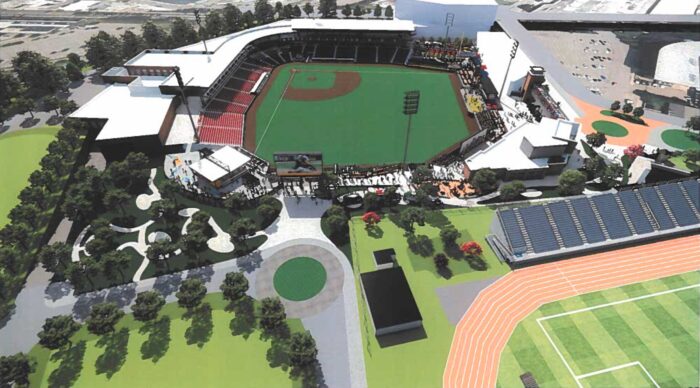
The stadium’s main entrance would be on the east side and open out to the Diamond District’s planned linear park.
The larger stadium footprint and other considerations have required a reduction in the size of a planned linear park from 11 to 8 acres. An additional 2 acres of park and open space would be included between buildings to be developed along Hermitage Road.
The number of secondary roads connecting Hermitage and Arthur Ashe Boulevard through the site have been reduced from six to three, and the number of blocks in the site have been reduced from 19 to 13, but with larger block sizes. Ebert said those changes are aimed at reducing infrastructure costs.
Also reduced is the number of office building sites, which Ebert attributed to current demand for office space but said could be changed later. The total gross square footage for all commercial space across the 67-acre site has dropped from over 1 million to 318,000 gross square feet.
Previously approved community benefits remain unchanged, with the overall Diamond District project still requiring minority business participation and a mix of housing styles and price and rental ranges.
Ebert said the development area for Phase 1 was increased to provide enough development to repay the stadium bonds, which would make up $130 million of the $170 million in city-issued bonds. The stadium bonds would be general obligation bonds, while the remaining $40 million would be lease revenue bonds to cover the infrastructure improvements.
The stadium bonds would cover construction of the $110 million stadium as well as costs to design, acquire and equip it. The infrastructure bonds would be paid for with lease payments from the Flying Squirrels, which according to Ebert’s presentation would pay $66 million over 30 years.
That comes out to $2.2 million in annual lease payments on average, though a chart illustrating the payments show more rent would be paid in the first 10 years, with payments lowering thereafter. Stadium lease and development agreements between the ballclub’s ownership group and the city EDA have yet to be signed.
As to the city assuming the debt on all of the bonds, Ebert acknowledged in her presentation that the city had initially aimed to avoid taking on debt risk with the Diamond District, but noted that the project and market conditions have since changed.
“I know we said a hundred times we would never do this,” Ebert said. “In fact, we really were in a situation where this just makes a lot more sense, because of the major savings to the city and being able to move this forward. There were disadvantages with the (CDA)-bond approach.”
‘100-percent compelling’
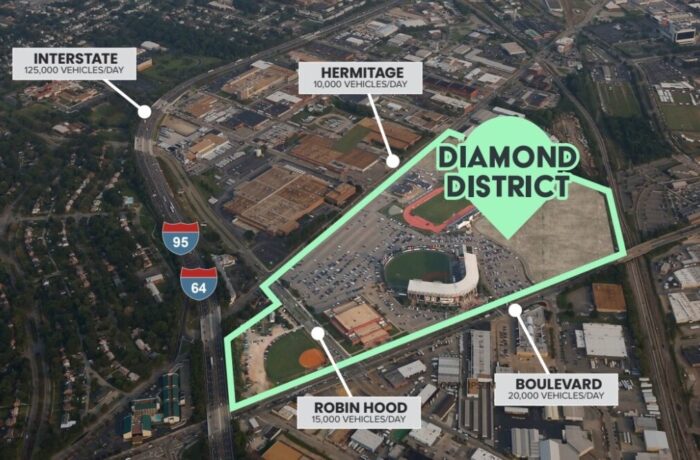
The 67 acres are bordered by Arthur Ashe Boulevard, Hermitage Road, the interstate and the railroad tracks.
In addition to the $215 million in projected debt savings, the city wants to issue its own bonds to secure the $24 million in state sales tax incentives that otherwise are set to expire July 1. Issuing its own bonds also would ensure a faster turnaround to complete the ballpark by the city’s April 2026 target. The ballpark is expected to take more than 18 months to build.
While the city is issuing its own bonds for the first phase, the CDA would still be an option to issue bonds for the rest of the $2.4 billion Diamond District development, which is expected to take 15 years to complete.
The CDA district would be returned to the boundaries of the 67-acre Diamond District site, freeing up additional adjacent properties that had been tacked onto the district through an expansion last year. Council also is to appoint the CDA’s five members at Wednesday’s meeting.
Following Ebert’s presentation, Councilmember Katherine Jordan, whose district includes the Diamond District site, remarked that she was hesitant about the changes at first but has become fully supportive of them.
“Getting the call that we were changing course on how we were financing it was not a call I wanted to take. But I sat with it, I’ve looked at the numbers you’ve presented, and it’s 100-percent compelling to me,” Jordan said.
“Whatever we would have gained at an accepted risk by the developers would not be worth continuing down this path and having to pay the increase on the bonds. Also, we have gained back the ability to sell these future phases at market rate,” she said. “We’ve maybe assumed a little bit of risk, but is the risk that nothing will happen in this area? Things are being built right and left. This area is going to be successful.”
Describing the Flying Squirrels ballclub as also successful and a proven community partner, Jordan continued, “We have promised them a stadium; we are long overdue on making good on that promise. This path, I believe, gives us the most prudent direction to complete it.
“The Squirrels are not getting a free stadium. That’s been said,” Jordan added. “This is a city asset that we will own. We were going to own it no matter what financing plan we took. The Squirrels are going to be paying rent, and that’s $66 million in rent. That is not to be overlooked.”
Responding to questions from other councilmembers about repayment of the bonds, Ebert reiterated that the new plan comes with risk. But she said that risk comes with low probability.
Noting the development occurring in the Scott’s Addition area and the attendance that the Flying Squirrels continue to draw, Ebert said, “Is it possible that none of the private development happens in the Diamond District? Yeah, that’s possible. We could have a catastrophic economic downturn tomorrow, just like we had in 2008 where all of a sudden the world turned upside down and the markets flipped.
“It’s possible, but I don’t think it’s probable,” she said. “We see development happening all around the Diamond District.”
Following Wednesday’s special meeting, the city has scheduled the first of three open houses for the public to review and weigh in on design standards for the Diamond District’s public spaces.
Wednesday’s virtual session starts at 6 p.m., and an in-person open house will be held Thursday from 5 to 7 p.m. at the former Bon Secours Training Center at 2401 W. Leigh St. A second virtual session is scheduled May 14 at 6 p.m.
With a vote scheduled Wednesday on the city’s revamped proposal to finance the ballpark-anchored Diamond District development, Richmonders for and against the new plan will have a chance to step up to the plate and be heard by City Council.
A special meeting is scheduled for 3 p.m. tomorrow for council to consider a group of ordinances that would advance the new approach to financing the stadium and infrastructure improvements for the Diamond District’s first phase, the scope of which has changed along with the funding method.
Citizens can weigh in during Wednesday’s hearing, which was initially planned to be held at council’s April 22 meeting but was moved to the May 8 special meeting.
Where the Diamond District’s first phase had been planned to be financed primarily using higher-interest bonds through a community development authority (CDA), Richmond’s administrators and financial advisor Davenport & Co. are now recommending that the city issue $170 million of its own bonds to secure the funding more quickly and at less cost in terms of debt.
The move is projected to save the city $215 million in debt costs over the 30-year length of the loans, while also capturing $24 million in expiring state sales tax incentives and freeing up other funds and adjacent properties that were needed with the CDA approach.
The catch is that the city would assume the debt on the $170 million in bonds, meaning it would be responsible for repaying that amount if the stadium isn’t built or the larger Diamond District project does not pay for itself with tax revenue generated by the development over time.
A majority of councilmembers have indicated support for the new plan, with seven of the nine members joining Mayor Levar Stoney as patrons of the ordinances. Members Ann-Frances Lambert and Nicole Jones are not listed as patrons.
Supporters maintain that the savings to the city, as well as the popularity of the Scott’s Addition area and of the Richmond Flying Squirrels, make the risk to the city a safe bet. Opponents contend that the change is being pushed and rushed since the ordinances were introduced last month.
The May 8 meeting had been previously announced but wasn’t officially added to the city’s meeting schedule until this week.
First phase is changed
The four ordinances to be voted on would authorize the city to enter into an agreement with Diamond District Partners, the private development team led by Thalhimer Realty Partners and Loop Capital, to purchase and develop the land for the first phase.
The ordinances also would authorize the $170 million in bonds; approve an infrastructure agreement between the city and its Economic Development Authority, which owns the Diamond District site; and create a CDA for future phases.
Diamond District Partners would pay $25 million in three installments through 2030 for the first-phase land, which would be developed in three sub-phases and total nearly 32 acres.
Under the new plan, the developer is committed to purchase only the land for the first sub-phase – about a dozen acres for $11.4 million. The prior plan called for the group to purchase the full 67-acre site at a cost of $80 million.
In a presentation last month to council’s Finance and Economic Development Standing Committee, Deputy Chief Administrative Officer Sharon Ebert said that change allows the city to take the remaining 35 acres back to the market if it so chooses, with Diamond District Partners given first right to match any other development offer received.
Ebert said the city could get over $140 million for the remaining acreage if it was sold in the open market today.
“That’s an asset to the city, to be able to achieve that and potentially a tremendous amount of more money in future years,” she said.
The first phase had previously totaled 22 acres, with the ballpark filling a 7-acre footprint. The 10,000-seat stadium now would fill a 10-acre footprint and has been taken off Diamond District Partners’ plate, with development responsibilities for the ballpark given to the Flying Squirrels’ ownership group and consultant Machete Group.
Diamond District Partners would develop the rest of Phase 1, which is now planned to total 1,336 residential units, up from 1,018 previously. Of those, 333 would be income-based units, compared to 194, and the phase would now include at least 24 for-sale homes, which were previously planned for later phases.
Bigger stadium, smaller park

The stadium’s main entrance would be on the east side and open out to the Diamond District’s planned linear park.
The larger stadium footprint and other considerations have required a reduction in the size of a planned linear park from 11 to 8 acres. An additional 2 acres of park and open space would be included between buildings to be developed along Hermitage Road.
The number of secondary roads connecting Hermitage and Arthur Ashe Boulevard through the site have been reduced from six to three, and the number of blocks in the site have been reduced from 19 to 13, but with larger block sizes. Ebert said those changes are aimed at reducing infrastructure costs.
Also reduced is the number of office building sites, which Ebert attributed to current demand for office space but said could be changed later. The total gross square footage for all commercial space across the 67-acre site has dropped from over 1 million to 318,000 gross square feet.
Previously approved community benefits remain unchanged, with the overall Diamond District project still requiring minority business participation and a mix of housing styles and price and rental ranges.
Ebert said the development area for Phase 1 was increased to provide enough development to repay the stadium bonds, which would make up $130 million of the $170 million in city-issued bonds. The stadium bonds would be general obligation bonds, while the remaining $40 million would be lease revenue bonds to cover the infrastructure improvements.
The stadium bonds would cover construction of the $110 million stadium as well as costs to design, acquire and equip it. The infrastructure bonds would be paid for with lease payments from the Flying Squirrels, which according to Ebert’s presentation would pay $66 million over 30 years.
That comes out to $2.2 million in annual lease payments on average, though a chart illustrating the payments show more rent would be paid in the first 10 years, with payments lowering thereafter. Stadium lease and development agreements between the ballclub’s ownership group and the city EDA have yet to be signed.
As to the city assuming the debt on all of the bonds, Ebert acknowledged in her presentation that the city had initially aimed to avoid taking on debt risk with the Diamond District, but noted that the project and market conditions have since changed.
“I know we said a hundred times we would never do this,” Ebert said. “In fact, we really were in a situation where this just makes a lot more sense, because of the major savings to the city and being able to move this forward. There were disadvantages with the (CDA)-bond approach.”
‘100-percent compelling’

The 67 acres are bordered by Arthur Ashe Boulevard, Hermitage Road, the interstate and the railroad tracks.
In addition to the $215 million in projected debt savings, the city wants to issue its own bonds to secure the $24 million in state sales tax incentives that otherwise are set to expire July 1. Issuing its own bonds also would ensure a faster turnaround to complete the ballpark by the city’s April 2026 target. The ballpark is expected to take more than 18 months to build.
While the city is issuing its own bonds for the first phase, the CDA would still be an option to issue bonds for the rest of the $2.4 billion Diamond District development, which is expected to take 15 years to complete.
The CDA district would be returned to the boundaries of the 67-acre Diamond District site, freeing up additional adjacent properties that had been tacked onto the district through an expansion last year. Council also is to appoint the CDA’s five members at Wednesday’s meeting.
Following Ebert’s presentation, Councilmember Katherine Jordan, whose district includes the Diamond District site, remarked that she was hesitant about the changes at first but has become fully supportive of them.
“Getting the call that we were changing course on how we were financing it was not a call I wanted to take. But I sat with it, I’ve looked at the numbers you’ve presented, and it’s 100-percent compelling to me,” Jordan said.
“Whatever we would have gained at an accepted risk by the developers would not be worth continuing down this path and having to pay the increase on the bonds. Also, we have gained back the ability to sell these future phases at market rate,” she said. “We’ve maybe assumed a little bit of risk, but is the risk that nothing will happen in this area? Things are being built right and left. This area is going to be successful.”
Describing the Flying Squirrels ballclub as also successful and a proven community partner, Jordan continued, “We have promised them a stadium; we are long overdue on making good on that promise. This path, I believe, gives us the most prudent direction to complete it.
“The Squirrels are not getting a free stadium. That’s been said,” Jordan added. “This is a city asset that we will own. We were going to own it no matter what financing plan we took. The Squirrels are going to be paying rent, and that’s $66 million in rent. That is not to be overlooked.”
Responding to questions from other councilmembers about repayment of the bonds, Ebert reiterated that the new plan comes with risk. But she said that risk comes with low probability.
Noting the development occurring in the Scott’s Addition area and the attendance that the Flying Squirrels continue to draw, Ebert said, “Is it possible that none of the private development happens in the Diamond District? Yeah, that’s possible. We could have a catastrophic economic downturn tomorrow, just like we had in 2008 where all of a sudden the world turned upside down and the markets flipped.
“It’s possible, but I don’t think it’s probable,” she said. “We see development happening all around the Diamond District.”
Following Wednesday’s special meeting, the city has scheduled the first of three open houses for the public to review and weigh in on design standards for the Diamond District’s public spaces.
Wednesday’s virtual session starts at 6 p.m., and an in-person open house will be held Thursday from 5 to 7 p.m. at the former Bon Secours Training Center at 2401 W. Leigh St. A second virtual session is scheduled May 14 at 6 p.m.

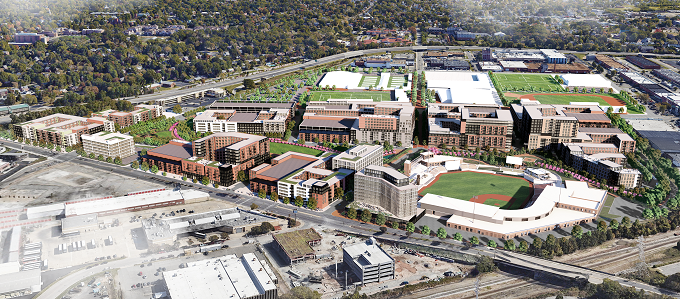
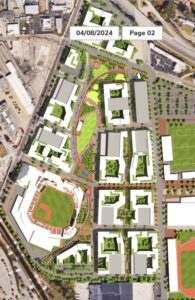
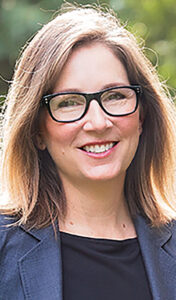


Richmond never learns….another boondoggle in the making…
I gave up expecting positive things from our city government a long time ago. They played with the numbers this year to make my car tax go up and the skyrocketing assessments keep raising my real estate tax. They only care about the look-how-much-house-I-can-get-for-my-money-by-moving-down-here crowd. I don’t give a rat’s patooty about this stadium.
A renovation of the existing statium could have been done years ago, possibly keeping the Braves in Richmond.
I think it was determined that a renovation was unviable? If not, I agree with you.
There wasn’t space within the current diamond footprint to make all of the necessary changes to be both ADA compliant and to meet MLB’s requirements.
MLBs requirements in 2001??? He said a renovation earlier. The City first started the replacement process before the Braves left. MLB did not control minors back then. But no guarantee that take over in 2020 would not have required some improvements. But as far as I know the Tides (still AAA) are not spending $120M to continue to operate.
The Tides facility was in better shape to start with- and if we had renovated more in ’01, we’d have had those expenses PLUS still be on the hook for not meeting requirements now. So Richmond’s incompetence in getting that work done earlier actually saved money in the long run- although getting a new stadium approved when construction costs were much lower would have been ideal.
So now,we have space,a whole District of space.Hows that working out?
100m+ I’m sure renovation plans would include the requirements.
looks like it’s about to work out just fine, actually.
except no one wanted the Braves… the squirrels have been much more popular.
Redskins practice field all over again.
”City hall is a cesspool of incompetance and corruption.” L Dougls Wilder
Doug Wilder was the only one who seemed to stand up to corruption, and that is why so many in Richmond hate the guy.
My father told me long ago that the most dangerous thing was to be a true reformer, because there will always be a confederacy of rent-seekers lined up to oppose and depose you.
With a 170 million dollars they could’ve built 2 new middle schools .
Or maybe actually maintained some older, very well built schools, like well run munis do.
This is interesting — +21 net UPVOTES on THIS comment, instead of the average -5 …. why is THIS comment resonating with how people already understand reality? I am surprised, since I don’t think most Richmonders understand how Richmond city hall seemingly deliberately defers maintainence so that they can shame Virginia and Washington to get them to abandon perfectly good buildings to build new ones — which all seems very corrupt and unfair to blame people who are not at fault for Richmond’s internal woes and get money to award to local contractors to build bldgs that don’t need to… Read more »
And then not have continuing taxes to add to the operating budget to maintain them. While I think the schools do need to be done sooner than later you can’t simply stop everything else to do so.
Personally, I hope they pull this off. I’m sick of losing entertainment options and the Squirrels have been a wonderful part of our city.
Well, I think we ALL hope so too — but one needs to point out that this should all have been finished by now, and would have if it wasn’t a bunch of political science majors managing the whole affair.
…… the two elephants in the room: If the Partners are not going to pay for the stadium like the agreement said, why are LOCAL outfits still getting this opportunity and why not reopen the bidding process to the BIG deep pocketed national players who can do more, have more access to capital etc. 2, All these “political” considerations — look at how long it took to redo the farmers market by Main St. station and the businesses that suffered while the management of that was about as bad as could be. Have we forgotten how bad that was? All… Read more »
If I am reading it correctly it sounds like that remaining acreage could be opened for that.
I think that would be most charitably referred to as a “silver lining” — and certainly not something the City Hall caused to happen — in fact, I would not be at all surprised if they gave it away in some corrupt deal that they directed the contracts toward the highest, slowest bidder as a precondition.
Every time I look at the rendering I wonder where the needed parking will be l
Frankly, its meaningless that the Special Meeting will be open for citizen comments. This is a fait accompli. If this doesn’t pass the ballpark, and the Squirrels will be toast.
Groundbreaking needs to be ASAP or the stadium won’t be ready for the opening of the 2026 season.
Well, the only thing we can do is tell all Virginians how bad they do things in Richmond city hall to make sure Virginia doesn’t hire them to screw things up at a larger level with more at stake.
Hey, you mentioned Parking — are you LOOKING for trouble? Everyone is supposed to wheelie their way there from Broad Street.
Have no fear about parking. I’m sure the Pulse can get everyone there.
You’re kidding…. right?
Very much so…
Just wanted to make sure, because I want everyone to Lime Scooter there.
Where’s Parker Field when you need it .
How does the scheme SAVE “the city $215 million in debt costs” if the original concept was it financed with CDA bonds that did not even a moral obligation to cover a penny in bonds? It was to all be 100% developer risks so we were told. Now it is “better’ to take 100% of the risk cause that will save “us” funds! To me you are now saying we know the revenue will not cover the bonds payments so let ensure the bond payments are the lowest cost possible.
Didn’t you ever hear about “How to tell if a politician is lying?”
Headlines more or less paraphrased over the last four years by city council and the developers. “We must be complete by 2025 to meet MLB minimum minor league ballpark standards”. “Oh wait, we aren’t going to make it so can we ask for forgiveness and make it by opening day 2026”. “We can still make opening day 2026 if we start moving dirt by opening day 2024”. We are now 27 games into the 2024 season and the current headline is “city council to vote on financing agreement” meanwhile the design is still fluid. They better start making plans for… Read more »
To all the city dwellers that love the urban life, the rendering of this new ballpark district sure looks like a suburban mecca.
Good point. It’s still not bad though — I LIKE green spaces, for example — it reminds of a suburban CAMPUS, to be specific — like a corporate HQ or modern college campus.
Spare us the drama!
i moved away from richmond 10 years ago and richmond was talking about building a new baseball stadium then. I think it was an old tired issue even back then.
how has it taken over 10 years to build this? what company would want to invest in a city that cant get a minor league stadium built over the course of 20 years.
Richmond has let the perfect be the enemy of progress so many times when it comes to big swings for decades. just build it
Or — just don’t build it, sell the land to the combo of the highest bidder/people who will build the most valuable assets that will fill city coffers the most so they can spend more money wisely or foolishly. It would be even better if they could do this 5 years ago.